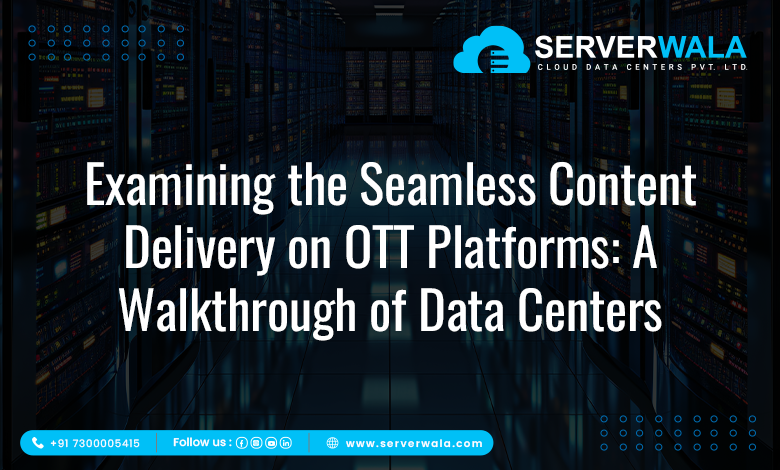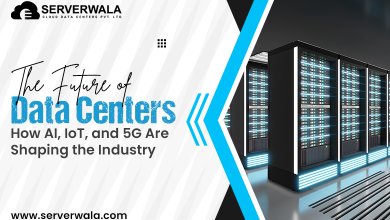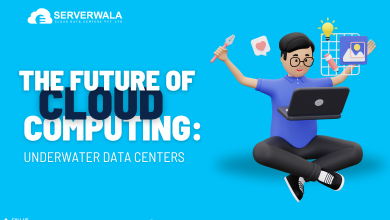Examining the Seamless Content Delivery on OTT Platforms: A Walkthrough of Data Centers

Overview of Data Centers in OTT Platforms
OTT (Over-The-Top) platforms have revolutionized the way content is delivered and consumed, offering a wide array of movies, TV shows, etc., to viewers directly via the WWW. At the heart of this seamless content delivery lie data centers, which serve as the backbone of OTT platforms. These data centers are sophisticated facilities housing servers, storage systems, networking equipment, and other infrastructure necessary to store, process, and distribute vast amounts of digital content to users worldwide.
Data centers play a pivotal role in ensuring uninterrupted streaming experiences for millions of users by efficiently managing content delivery, minimizing latency, and optimizing bandwidth usage. They serve as the nerve center of OTT platforms, enabling content providers to deliver high-quality videos, support concurrent streaming sessions, and personalize content recommendations based on user preferences and viewing habits.
Role of OTT Platforms in Content Delivery
Democratization of Entertainment:
OTT platforms have democratized access to entertainment by breaking down barriers to entry traditionally associated with cable subscriptions or physical media. Users are not required to stick to rigid schedules or purchase expensive cable packages to access their preferred content. Instead, they can enjoy an extensive library of films, television shows, documentaries, & original programming at their convenience.
Global Accessibility:
The considerable advantage of OTT platforms is their global availability. Unlike traditional broadcasting models limited by geographical boundaries, OTT platforms can reach audiences worldwide, transcending language and cultural barriers. This global reach allows content creators to connect with diverse audiences and explore new markets previously inaccessible through traditional distribution channels.
Personalized Content Recommendations:
OTT platforms leverage sophisticated data analytics & ML algorithms to personalize content recommendations for users. By evaluating user behavior, watching history, & desires, these platforms curate tailored content suggestions, enhancing user engagement & retention. Personalization intensifies the user experience and helps content providers optimize content delivery by surfacing relevant content to individual users.
Enhanced User Engagement:
Interactivity is a key aspect of OTT platforms, fostering deeper engagement between content creators and consumers. Features such as interactive storytelling, viewer polls, and social media integration encourage active participation from users, transforming passive viewers into active participants. Enhanced user engagement not only strengthens brand loyalty but also generates valuable feedback for content creators to refine their offerings and adapt to evolving consumer preferences.
Optimized Content Delivery:
OTT platforms employ advanced technologies for optimizing content delivery as per network conditions and device capabilities. Adaptive bitrate streaming, for example, dynamically adjusts video quality according to the accessible bandwidth, guaranteeing smooth playback and minimizing buffering. CDNs distribute content across geographically dispersed servers, lessening latency & improving streaming performance. These optimizations collectively contribute to a smooth viewing experience.
Monetization Opportunities:
OTT platforms offer diverse monetization opportunities for content creators, ranging from subscription-based models to advertising-supported content and pay-per-view options. Subscription-based models provide recurring revenue streams, while targeted advertising enables advertisers to reach specific audience segments effectively. Additionally, premium content offerings and merchandise sales further diversify revenue streams, creating a sustainable business model for content creators and platform operators alike.
Content Discovery and Exploration:
OTT platforms facilitate content discovery and exploration through intuitive interfaces, recommendation algorithms, and curated collections. Users can easily navigate through vast content libraries, discover new titles based on their interests, and explore curated playlists and thematic collections. Furthermore, social features such as user-generated reviews, ratings, and shared playlists foster a sense of community and facilitate content discovery through word-of-mouth recommendations.
Seamless Cross-Device Experience:
With the proliferation of smart devices, OTT platforms offer a seamless cross-device experience, permitting users to transition smoothly between different screens without interrupting their viewing experience. It does not matter if streaming on a smart television, smartphone, or laptop, users can opt from where they stopped, thanks to synchronization features and cloud-based storage solutions. This flexibility enhances user convenience and accessibility, accommodating the various lifestyles of modern consumers.
Case Studies: OTT Platforms and Data Center Strategies
Netflix:
As one of the pioneers in the OTT space, Netflix has invested significantly in building and optimizing its data center infrastructure. With a global subscriber base and a vast library of content, Netflix operates a distributed network of data centers wisely placed across the globe. These data centers are held with avant-garde hardware and networking infrastructure to assure low-latency streaming and high availability for millions of subscribers. Netflix’s data center strategy emphasizes redundancy and scalability, allowing the platform to handle surges in demand during peak hours and major content releases seamlessly.
Amazon Prime Video:
Amazon Prime Video, a subsidiary of Amazon.com, leverages the extensive infrastructure of Amazon Web Services (AWS) to power its streaming platform. AWS operates a worldwide network of data centers, providing Amazon Prime Video with the scalability and reliability needed to deliver high-quality video streaming to users worldwide. By utilizing AWS’s cloud services, Amazon Prime Video can dynamically scale its infrastructure based on demand, optimizing resource utilization and cost-effectiveness. This hybrid cloud approach enables Amazon Prime Video to maintain a competitive edge in the OTT market while ensuring seamless content delivery across devices and regions.
Disney+:
Disney’s entry into the OTT market with Disney+ marked a significant milestone in the streaming industry. To support its ambitious growth plans and extensive content library, Disney adopted a hybrid cloud strategy, combining on-premises data centers with cloud services from providers like AWS and Microsoft Azure. This hybrid approach allows Disney+ to employ the scalability as well as versatility of cloud computing while sustaining administration over critical infrastructure components. By strategically distributing workloads between on-premises data centers and cloud environments, Disney+ ensures optimal performance, reliability, and cost efficiency for its streaming platform.
Hulu:
Hulu, a joint venture between Disney, Comcast, and WarnerMedia, also relies on a hybrid cloud model to deliver streaming content to its subscribers. By combining on-premises data centers with cloud infrastructure, Hulu achieves agility and scalability while mitigating operational complexities and costs. This hybrid approach enables Hulu to adapt to fluctuating demand, optimize resource utilization, and enhance the overall user experience. Additionally, Hulu leverages cloud-based analytics and machine learning services to gain insights into viewer behavior, personalize content recommendations, and improve content discovery, further enhancing its competitive position in the OTT market.
What are the Challenges and Future Trends of the OTT Platform?
Providing high-quality content in a bandwidth-constrained environment
- Bandwidth constraints pose a significant challenge for OTT platforms, particularly in regions with limited internet infrastructure or slow connectivity speeds. Delivering high-quality video content requires substantial bandwidth, which may not be readily available to all users.
- To address this challenge, OTT platforms are exploring innovative solutions such as adaptive bitrate streaming and video compression technologies. Adaptive bitrate streaming dynamically adjusts video quality according to accessible bandwidth, guaranteeing hassle-free playback even in bandwidth-constrained environments.
- Furthermore, advancements in video compression techniques, like HEVC and VVC, enable OTT platforms to deliver high-definition content efficiently while minimizing bandwidth requirements.
Data center infrastructure security considerations
- Security remains a top priority for OTT platforms, as they handle sensitive user data and financial transactions. Data center infrastructure security encompasses various aspects, incorporating network protection, data encryption, accessibility controls, & compliance with regulatory necessities.
- OTT platforms invest in powerful protection measures to secure against cyber threats, unauthorized accessibility, & data hacking. This incorporates executing firewalls, detection systems, encryption protocols, & multi-factor authentication mechanisms to safeguard data integrity and user privacy.
- Additionally, regular security audits, penetration testing, and employee training programs help ensure ongoing compliance with industry standards and best practices, enhancing the overall resilience of OTT platforms against evolving security threats.
How Evolving Technologies Are Molding OTT Platforms in the Future?
- Emerging technologies such as 5G networks, edge computing, artificial intelligence (AI), and virtual reality (VR) are poised to transform the landscape of OTT platforms in the future.
- 5G networks promise to deliver ultra-fast speeds, low latency, and high reliability, enabling seamless streaming experiences on mobile devices and IoT devices. This opens up new opportunities for OTT platforms to deliver immersive content and interactive experiences to users.
- Edge computing renders processing power closer to the end-user, reducing latency and letting real-time content delivery. OTT platforms can leverage edge computing to optimize content delivery, enhance interactivity, and support emerging use cases such as augmented reality (AR) and mixed reality (MR) experiences.
- AI technologies perform a critical role in content recommendation, content moderation, and video analytics. OTT platforms use AI algorithms to personalize content recommendations based on user preferences, automate content moderation to ensure compliance with community guidelines and analyze video content for insights into viewer engagement and sentiment.
- VR technologies render interactive storytelling possibilities, permitting users to experience content in virtual platforms. OTT platforms can harness VR technology to create immersive movie-watching experiences, interactive documentaries, and virtual concerts, blurring the lines between traditional media consumption and virtual reality entertainment.
Also Read: What are Edge Data Centers?
End Thoughts on the Technology’s Role in Content Consumption
Technology plays a pivotal role in shaping the future of content consumption, with OTT platforms at the forefront of this digital transformation. Data centers serve as the backbone of OTT platforms, enabling efficient content delivery, personalized recommendations, and secure transactions. As technology continues to evolve, OTT platforms will need to innovate and adapt to meet the evolving demands of users while ensuring a seamless and immersive content experience across all devices and platforms.





